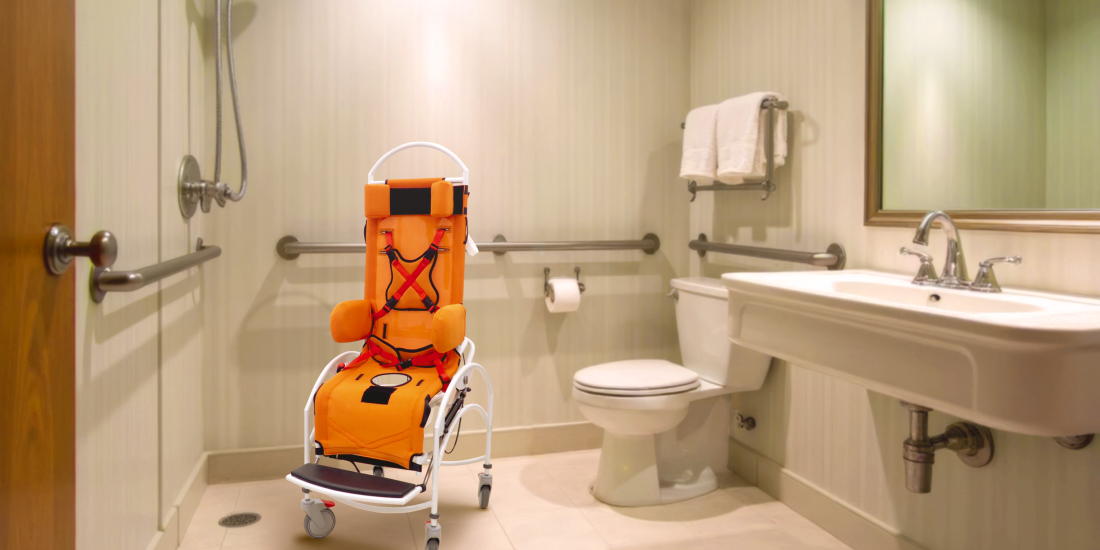
Safe Transitions: Assessing Mobile Shower Commode Chairs in Practice
Webinar Recording
This blog is supplementary to our webinar in July 2025 on Safe Transitions: Moving and Handling Risk Assessments for Mobile Shower Chairs and Commodes, you can watch the full webinar below:
Blog


Mobile shower chair commodes (MSCs) are essential for promoting dignity, safety, continence care and hygiene during personal care. Choosing the right chair requires a holistic assessment approach, integrating moving and handling risk factors with posture, skin integrity, and environmental considerations. This ensures that each person receives equipment that meets their functional, health, and hygiene needs effectively.
One key consideration is propulsion. Clinicians should assess whether the person can self-propel, which requires adequate upper limb strength, coordination, and endurance, alongside trunk stability to avoid falls or sideways leaning. Where self-propulsion is not possible, it is important that carers are trained in safe pushing techniques, taking into account the MSC’s weight, floor surfaces, and any gradients in the environment.
Accurate body measurements remain fundamental. Measuring seat width, depth, and height ensures correct fit and comfort, while back support height and lower leg length measurements facilitate optimal posture and footrest positioning. Equally, environmental measurements are crucial – door widths, shower spaces, and turning circles must accommodate the equipment to ensure it can be manoeuvred safely in the person’s home or care setting.
The person’s postural support needs must be assessed thoroughly. Consider whether they can maintain an upright trunk posture independently or require additional lateral supports or tilt-in-space functions for stability. Head support may be necessary for individuals with neck weakness, while arm supports should be checked for height adjustability, removability, or flip-up functions to facilitate safe transfers and positioning.
Transfers themselves are a major area of risk and require careful assessment. Options may include hoisting, using mobile or ceiling track hoists for those unable to weight-bear; stand aids for individuals able to bear weight through their legs and maintain grip strength; and turners for clients who can partially weight-bear and pivot with support. Clinicians should evaluate cognition, fatigue levels, ability to follow instructions to determine the safest transfer method and ensure that this is reviewed regularly as functional capacity changes.
The duration of use is another crucial factor. Prolonged sitting increases risks of fatigue, postural collapse, and skin tissue breakdown. Selecting an MSC with appropriate cushioning, support, and tilt or recline functions is important when longer durations are anticipated.
Considering seat shape and aperture design is essential for both hygiene and comfort. Horseshoe apertures, for example, may facilitate perineal access, while full seats can be beneficial for those at high risk of skin breakdown who do not require toileting apertures. The choice of seat should not compromise skin integrity or hygiene effectiveness.
Pressure care considerations are vital, particularly for users with reduced sensation or existing skin damage. Clinicians should assess whether the MSC seat offers adequate cushioning, foam, gel, or pressure-relieving options and ensure compatibility with specialist cushions if required to reduce the risk of pressure injuries. Compatibility with equipment such as wash/dry wc and calibration to allow for activation may also be required.
For clients in the community, portability of equipment is often critical, removable components, and overall weight all affect whether an MSC can be transported safely for hospital appointments or travel, or stored compactly when not in use.
Another important consideration is the progression of the individual’s condition. Equipment should be adaptable to changing needs, such as adjustable seat heights to aid transfers as strength declines, or additional supports as trunk control reduces. Regular reassessment is therefore vital to maintain safety and ensure the chair continues to meet the user’s functional requirements.
Safety features must never be overlooked. Checking braking systems is essential to prevent unwanted movement during transfers, and ensuring footrests adequately support the feet prevents undue pressure behind the knees. Additionally, infection control protocols should align with local policies to reduce cross-contamination risks.
Finally, clinicians should always combine functional assessment, skin integrity evaluation, and moving and handling risk assessment into a holistic approach. This avoids siloed assessments that may miss key risks or client needs, instead supporting safety, dignity, and health outcomes simultaneously. It also ensures assessments remain person-centred, addressing critical questions such as: Can the individual maintain an upright posture? Do they have the upper limb reach, strength, and endurance to complete hygiene tasks effectively and safely, even when fatigued?
Clear documentation of these factors within assessment, informing equipment prescriptions and care plans, reducing the risk of unsafe or incomplete hygiene practices. In turn, this approach aligns with UK best practice across community, hospital, and care home settings, and ensures that each person’s safety and dignity, remain at the heart of care planning.
Further reading
https://www.hcpc-uk.org/standards/meeting-our-standards/record-keeping/
Issue 1: Falls from improper use of equipment - Care Quality Commission 22 September 2022.
Lustig, Levy, Kopplin, Ovadia, Blechman, Gefen Journal of Tissue Viability Volume 27, Issue 1, February 2018, Pages 23-31




